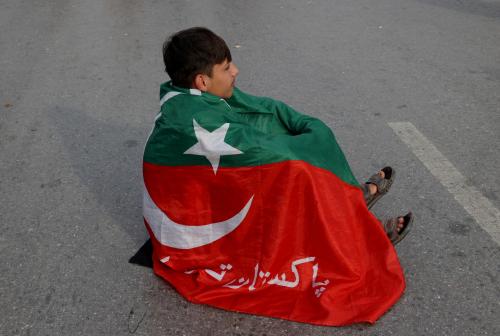The U.S.-Pakistan relationship has weathered several bumps in the road over the past two years, including, most prominently, the fallout from the Afghanistan withdrawal and the Taliban takeover. The Biden administration has now settled on a bureaucratic division of labor in its policy toward Pakistan: a lack of engagement from the White House; robust, well-defined engagement from the State Department; and a continuation of long-standing military and defense ties. The new equilibrium is different from the past: President Joe Biden is the only U.S. president in recent memory not to have engaged with a Pakistani prime minister (neither Imran Khan nor his successor, Shehbaz Sharif). The bilateral relationship is also notably no longer centered solely around America’s interests in Afghanistan, as it was prior to August 2021: there is an effort by both sides to broaden its base.
Unfortunately, the overall relationship is weak at best. Here are the factors that have shaped the relationship over the last two years:
The Afghanistan factor
At the beginning of the Biden administration, Pakistan recognized the need to redefine the bilateral relationship, until then focused on Afghanistan, as the U.S. withdrawal from that country drew close. Prime Minister Imran Khan’s government pitched the need for a comprehensive relationship with the United States, one based on “geo-economics” — Pakistan’s catch-all for trade, investment, and connectivity — as opposed to a relationship focused on security concerns. The Biden administration wasn’t responsive, and the relationship got off to a cold start. At the time, the United States was focused on Afghanistan and the need for Pakistan to exercise pressure on the Taliban to push it toward an intra-Afghan peace. Then, as the Taliban undertook a systematic military takeover of Afghanistan while the United States withdrew, the relationship cooled further. In the months afterward, although Pakistan helped in evacuations from Kabul and in taking in Afghan refugees, the ignominy of the withdrawal — that the war ended with a clear Taliban victory and in view of Pakistan’s close relationship with the Taliban — pushed relations to a relative low point.
No phone call
Biden has not called a Pakistani prime minister in his more than two years in office. Biden neither mentioned Pakistan during the withdrawal from Afghanistan, nor showed any interest in engaging with the country at that point. The lack of a phone call drew considerable attention in Pakistan during Biden’s first year in office, and was ostensibly one of the reasons Khan declined the administration’s invitation to attend the first Summit for Democracy in December 2021. Even Pakistan’s catastrophic summer flooding in 2022, which elicited a robust U.S. government response, did not prompt a Biden call. Yet in October 2022, seemingly out of the blue, Biden mentioned Pakistan in strongly negative terms at a Democratic Congressional Campaign Committee reception, describing it as “what I think is maybe one of the most dangerous nations in the world: Pakistan. Nuclear weapons without any cohesion.” This statement did not go over well in Pakistan, prompting a bit of a walk back from the administration, though Biden may have really meant what he said.
Initially, the complete lack of White House engagement with Pakistan was somewhat of a puzzle. Now though, it seems it’s White House policy — reflecting the fact that Pakistan is not a priority. For Biden, it might draw from a desire to put Afghanistan behind him — and with it, its neighbor. Throughout Biden’s many years of watching the Afghanistan war from the Senate and then as vice president, Pakistan’s relationship with the Taliban had always been a source of tension.
Pakistani politics
In the spring of 2022, America was drawn into Pakistan’s domestic politics in a sudden, unfavorable manner: Khan blamed his ouster via a vote of no confidence on a U.S. “regime change” conspiracy, without evidence — a narrative that stuck among his supporters. In recent months, Khan has stepped back from the U.S. conspiracy narrative and has more directly blamed the Pakistani military for the fall of his government — the actual story. Still, the narrative complicated the U.S. relationship with Pakistan for months in 2022, as Khan’s supporters considered any engagement between the United States and the new government in Islamabad to be confirmation of the conspiracy.
Ties with State, and broadening the relationship
Although the White House remained silent, Secretary of State Antony Blinken and Khan’s foreign minister, Shah Mahmood Qureshi, spoke several times and met in New York in September 2021. Spring 2022 began a period of robust engagement from the State Department, a mini reset of sorts that has focused on expanding the relationship. In March 2022, the United States and Pakistan launched a year-long campaign marking 75 years of relations. In April, the new U.S. ambassador to Pakistan, Donald Blome, was sworn in. In May, Pakistan’s new foreign minister, Bilawal Bhutto Zardari, met Blinken in New York. The U.S. special representative for Commercial and Business Affairs, Dilawar Syed, visited Pakistan in July to “strengthen the economic partnership and bilateral trade” between both countries. Also in July, the two governments launched a health dialogue. Soon after Pakistan’s flooding disaster hit in August, U.S. Agency for International Development Administrator Samantha Power visited the country, documenting both the catastrophe as well as U.S. relief assistance; the United States has announced more than $200 million in flood assistance. Bhutto Zardari and Blinken met again in September when the 75th anniversary of U.S.-Pakistan relations was officially celebrated at the State Department. The relationship between the two counterparts appears constructive; it has focused on relief and recovery after Pakistan’s calamitous summer of flooding and increasing cooperation on economic matters.
Engagement and diplomacy continue apace on other fronts: State Department Counselor Derek Chollet and a delegation of senior U.S. government officials visited Pakistan in February 2023 in support of the U.S.-Pakistan relationship. The Pakistani commerce minister visited Washington the same month to hold a meeting under the U.S.-Pakistan Trade and Investment Framework — held after seven years — with United States Trade Representative Katherine Tai. Also in February, a U.S. congressional delegation led by Senate Majority Leader Chuck Schumer visited Pakistan to discuss the “broad-based partnership that includes trade, investment, regional security, and flood recovery efforts.” Pakistan has also been the single largest recipient of COVID vaccines from the United States since 2021.
Defense and military ties
The military leadership in Pakistan had a major transition last fall, with the chief of army staff, General Qamar Javed Bajwa, leaving his post after six years (following an extension). He visited Washington in October before his term ended and met Secretary of Defense Lloyd Austin. And the commander of United States Central Command, General Michael Kurilla, traveled to Pakistan to reaffirm security ties after the new chief of army staff, General Asim Munir, was sworn in.
The long-standing defense and security relationship continues (though it is no longer the entirety of the bilateral relationship). In September, the U.S. government notified Congress of a proposed $450 million foreign military sale to maintain Pakistan’s fleet of F-16 fighter jets. The security relationship also includes a key focus on counterterrorism and intelligence that presumably encompasses an over-the-horizon arrangement on Afghanistan — but that specific aspect remains shrouded in secrecy. CIA Director Bill Burns visited Pakistan twice in 2021: once in an unannounced visit in April and then again after the withdrawal in September.
What limits the relationship
Pakistan is in a very different place than when its government pitched a geo-economic reset in early 2021. It is now mired in a political and economic crisis, veering perilously close to default. For the time being, its spiraling economic situation and domestic problems limit its attractiveness as a U.S. partner.
Distrust born out of the last four decades of the U.S.-Pakistan-Afghanistan triangle will take time to overcome, despite both sides’ attempts in the last year at broadening the relationship. And while Afghanistan no longer defines the U.S. relationship with Pakistan, the Biden administration’s approach to its other neighbors, China and India, does restrict it. The administration’s intense competition with China, Pakistan’s long-standing ally; its growing partnership with India, Pakistan’s foe; and its focus on the Indo-Pacific (which excludes Pakistan) has led to a priority shift away from Pakistan. Pakistan has long said it doesn’t want its relationships with the United States and China to be seen as zero-sum, and the United States has acknowledged that it doesn’t see its relationships with India and Pakistan as zero-sum. Yet, the American approach to these two Pakistani neighbors does seem to, at this point, impose constraints on the bounds of the U.S.-Pakistan relationship.
This need not be the case: As I have long argued, Pakistan, the fifth-largest country in the world and a nuclear-armed nation, ought to be seen by the United States on its own terms and not through the prism of its neighbors. A cold shoulder risks pushing Pakistan further toward China — which is neither an inevitable nor desirable outcome for the United States. What’s more, Pakistan’s multiple crises — political instability, economic malaise, and rising insecurity — warrant greater American engagement, not less, and certainly more than the current administration’s policy of fractured engagement from the United States.
The Brookings Institution is committed to quality, independence, and impact.
We are supported by a diverse array of funders. In line with our values and policies, each Brookings publication represents the sole views of its author(s).









Commentary
The Biden administration’s two-track Pakistan policy misses the mark
March 2, 2023